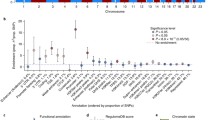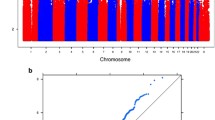Abstract
General cognitive ability (intelligence, often indexed by IQ scores) is one of the most highly heritable behavioral dimensions. In an attempt to identify some of the many genes (quantitative trait loci; QTL) responsible for the substantial heritability of this quantitative trait, the IQ QTL Project uses an allelic association strategy. Allelic frequencies are compared for the high and low extremes of the IQ dimension using DNA markers in or near genes that are likely to be relevant to neural functioning. Permanent cell lines have been established for low-IQ (mean IQ=82;N=18), middle-IQ (mean IQ=105;N=21), and high-IQ (mean IQ=130;N=24) groups and for a replication sample consisting of even more extreme low-IQ (mean IQ=59;N=17) and high-IQ (mean IQ=142;N=27) groups. Subjects are Caucasian children tested from 6 to 12 years of age. This first report of the IQ QTL Project presents allelic association results for 46 two-allele markers and for 26 comparisons for 14 multiple-allele markers. Two markers yielded significant (p<.01) allelic frequency differences between the high- and the low-IQ groups in the combined sample—a new HLA marker for a gene unique to the human species and a new brain-expressed triplet repeat marker (CTGB33). The prospects for harnessing the power of molecular genetic techniques to identify QTL for quantitative dimensions of human behavior are discussed.
Similar content being viewed by others
References
Allard, R. W. (1988). Genetic changes associated with the evolution of adaptedness in cultivated plants and their wild progenitors.J. Hered. 79:225–238.
Ashton, G. C. (1986). Blood polymorphisms and cognitive abilities.Behav. Genet. 16:517–529.
Bishop, J. E., and Waldholz, M. (1990).Genome, Simon and Schuster, New York.
Boerwinkle, E., Chakraborty, R., and Sing, C. F. (1986). The use of measured genotype information in the analysis of quantitative phenotypes in man.Ann. Hum. Genet. 50:181–194.
Bouchard, T. J., Jr., and McGue, J. (1981). Familial studies of intelligence.Science 212:1055–1059.
Chipuer, H. M., Rovine, M., and Plomin, R. (1990). LISREL modelling: Genetic and environmental influences on IQ revisited.Intelligence 14:11–29.
Cohen, J. (1988).Statistical Power Analysis for the Behavioral Sciences (2nd ed.), Erlbaum, Hillsdale, NJ.
Corder, E. H., Saunders, A. M., strittmatter, W. J., Schmechel, D. E., Gaskell, P. C., Small, G. W., Roses, A. D., Haines, J. L., and Pericak-Vance, M. A. (1993). Gene dose of apolipoprotein E type 4 allele and the risk of Alzheimer's disease in late onset families.Science 261:921–923.
Edwards, J. H. (1991). The formal problems of linkage. In McGuffin, P., and Murray, R. (eds.),The New Genetics of Mental Illness Butterworth-Heinemann, Oxford, pp. 58–70.
Edwards, M. D., Stuber, C. W., and Wendel, J. F. (1987). Molecular-marker-facilitated investigations of quantitative-trait loci in maize. I. Numbers, genomic distribution and types of gene action.Geneticae 116:113–125.
Everitt, B. S. (1992).The Analysis of Contingency Tables, 2nd ed., Chapman & Hall, London.
Fulker, D. W., Cardon, L. R., DeFries, J. C., Kimberling, W. J., Pennington, B. F., and Smith, S. D. (1991).Read. Writ. Interdis. J. 3:299–313.
Gelderman, H. (1975). Investigations on inheritance of quantitative characters in animals by gene markers. I. Methods.Theor. Appl. Genet. 46:319–330.
Gelernter, J., Goldman, D., and Risch, N. (1993). The A1 allele at the D2 dopamine receptor gene and alcoholism.JAMA 269:1673–1677.
Gulliken, H. (1950).Theory of Mental Tests, Wiley, New York.
Hauser, P., Zametkin, A. J., Martinez, P., Vitiello, B., Matochik, Mixson, A. J., and Weintraub B. D. (1993). Attention deficit-hyperactivity disorder in people with generalized resistance to thyroid hormone.N. Engl. J. Med. 328:997–1001.
Hill, W. G. (1974). Estimation of linkage disequilibrium in randomly mating populations.Heredity 33:229–239.
Hodge, S. E. (1993). What association analysis can and cannot tell us about the genetics of complex psychiatric disease.Psychiat. Genet. 3:137, (abstr.).
Humphries, S. E. (1988). DNA polymorphisms of the apolipoprotein genes: Their use in the investigation of the genetic component of the hyperlipidaemia and atherosclerosis.Atherosclerosis 72:89–108.
Innis, M. A., Gelfand, D. H., Sninskey, J. J., and White, T. J. (1990).PCR Protocols: A Guide to Methods and Applications, Academic Press, New York.
Jensen, A. R. (1980),Bias in Mental Testing, Erlbaum, Hillsdale, NJ.
Koshland, D. E. Jr. (1989). Sequences and consequences of the human genome.Science 246:189.
Lange, K. (1986). The affected sib-pair method using identity by state relations.Am. J. Hum. Genet. 39:148–150.
Li, S.-H., McInnis, M. G., Margolis, R. L., Antonarakis, S. E., and Ross, C. A. (1993). Novel triplet repeat containing genes in human brain: Cloning, expression, and length polymorphisms.Genomics 16:572–579.
Lidell, M., Williams, J., Bayer, A., Kaiser, F., and Owen, M. J. (1993). Confirmation of association between the E4 allele of apolipoprotein E and Alzheimer's disease.J. Med. Genet. (in press).
Lisitsyn, N., Lisitsyn, N., and Wigler, M. (1993). Cloning the differences between two complex genomes.Science 259:946–951.
McGuffin, P. (1991).DISEQ: A Program to Estimate Linkage Disequilibrium, University of Wales College of Medicine, Wales.
McGuffin, P., and Murray, R. (1991).The New Genetics of Mental Illness, Butterworth-Heinemann, Oxford.
McGuffin, P., and Sturt, E. (1986). Genetic markers in schizophrenia.Hum. Hered. 36:65–88.
McKusick, V. A. (1990).Mendelian Inheritance in Man, 9th ed., Johns Hopkins University Press, Baltimore, MD.
Morton, N. E. (1982).Outline of Genetic Epidemiology, Karger, Hasel.
Motulsky, A. G. (1983). Impact of genetic manipulation on society and medicine.Science 219:135–140.
Müller-Hill, B. (1993). The shadow of genetic injustice.Nature 362:491–492.
Nelkin, D., and Tancredi, L. (1989).Dangerous Diagnostics: The Social Power of Biological Information, Basic Books, New York.
Morton, N. E. (1982).Outline of Genetic Epidemiology, Karger, Hasel.
Nelson, S. F., McCusker, J. H., Sander, M. A., Kee, Y., Modrich, P., and Brown, P. O. (1993). Genomic mismatch scanning: A new approach to genetic linkage mapping.Nature Genet. 4:11–19.
Noble, E. P. (1993). The D2 dopamine receptor gene: A review of association studies in alcoholism.Behav. Genet. 23:119–129.
Owen, M. J., and McGuffin, P. (1993). Association and linkage: Complementary strategies for complex disorders.J. Med. Genet. 30:638–639.
Plomin, R. (1990). The role of inheritance in behavior.Science 248:183–188.
Plomin, R., and Neiderhiser, J. M. (1991). Quantitative genetics, molecular genetics, and intelligence.Intelligence 15:369–387.
Ploughman, L. M., and Boehnke, M. (1989). Estimating the power of a proposed linkage study for a complex genetic trait.Am. J. Hum. Genet. 44:543–551.
Propping, P., Nothen, M. M., Fimmers, R., and Baur, M. P. (1993). Linkage versus association studies in complex diseases.Psychiat. Genet. 3:136 (abstr.).
Risch, N. (1990). Linkage strategies for genetically complex traits. II. The power of affected relative pairs.Am. J. Hum. Genet. 46:229–241.
Sambrook, J., Fritsch, E. F., and Maniatis, T. (1989). Analysis of genomic DNA by Southern hybridization. In Sambrook, J., Fritsch, E. F., and Maniatis, T. (eds.),Molecular Cloning: A Laboratory Manual, Cold Spring Harbor Laboratory Press, New York, pp. 9.45–9.46.
Sims, K. B., and Caviness, V. S., Jr. (1991). Molecular genetics and mental retardation. In Brosius, J., and Fremeau, R. T. (eds.),Molecular Genetic Approaches to Neuropsychiatric Diseases, Academic Press, New York. pp. 367–425.
Sing, C. F., and Boerwinkle, E. A. (1987). Genetic architecture of inter-individual variability in apolipoprotein, lipoprotein and lipid phenotypes. In Bock, G., and Collins, G. M. (eds.),Molecular Approaches to Human Polygenic Disease, John Wiley & Sons, Chichester, UK, pp. 99–122.
Sobell, J. L., Heston, L. L., and Sommer, S. S. (1992). Delineation of the genetic predisposition to a multifactorial disease: A general approach on the threshold of feasibility.Genomics 12:1–6.
Sobell, J. L., Heston, L. L., and Sommer, S. S. (1993). Novel association approach for determining the genetic predis-position to schizophrenia: Case-control resource and testing of a candidate gene.Am. J. Med. Genet. (Neuropsychiat. Genet.)48:28–35.
Suarez, B. K., O'Rourke, D., and Van Eerdewegh, P. (1982). Power of the affected sib-pair method to detect disease susceptibility loci of small effect: An application to multiple sclerosis.Am. J. Med. Genet. 12:309–326.
Taylor, R. (1992). Mitochondrial DNA may hold a key to human degenerative diseases.J. NIH Res. 6:62–66.
Thompson, L. A., Detterman, D. K., and Plomin, R. (1991). Associations between cognitive abilities and scholastic achievement: Genetic overlap but environmental differences.Psychol. Sci. 2:158–165.
Tiwari, J., and Terasaki, P. I. (1985).HLA and Disease Associations, Springer, New York.
Travis, J. (1993). New piece in Alzheimer's puzzle.Science 261:828–829.
Uhl, G., Blum, K., Noble, E. P., and Smith, S. (1993). Substance abuse vulnerability and D2 dopamine receptor gene and severe alcoholism.Trends Neurosci. 16:83–88.
Venditti, C. P., Harris, J. M., Geraghty, D. E., and Chorney, M. J. (1993a). Four new multigene assemblages in the human MHC Class I region (submitted for publication).
Venditti, C. P., Piechocki, M., Smith, D. I., Geraghty, D. E., David, V., Le Gall, J.-Y., and Chorney, M. J. (1993b). Mapping, polymorphism, and haplotype studies of a multicopy family of dispersed genomic fragments with the MHC Class I region: Implications for the generation of the Class I family of sequences (submitted for publication).
Wahlsten, J. (1990). Gene map of mental retardation.J. Ment. Defic. Res. 34:11–27.
Wright, R. (1990). Achilles' helix.New Republic July 9–16:21–31.
Author information
Authors and Affiliations
Rights and permissions
About this article
Cite this article
Plomin, R., McClearn, G.E., Smith, D.L. et al. DNA markers associated with high versus low IQ: The IQ quantitative trait loci (QTL) project. Behav Genet 24, 107–118 (1994). https://doi.org/10.1007/BF01067815
Received:
Accepted:
Issue Date:
DOI: https://doi.org/10.1007/BF01067815




